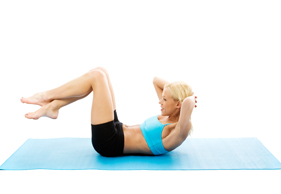When we talk about the core, we are referring to the
muscles deep within the abdomen and back, attaching to the spine or pelvis,
that work together with the more superficial muscles of the trunk to support
the spine and keep the body balanced and stable during movement. The transverse abdominis (a muscle layer on
the front and side of the abdominal wall)
is the major abdominal ‘core’ stabiliser, along with the multifidus (muscle along the vertebrae) and the quadrates lumborum (lower back muscle). However, if one is doing a
simple squat, for example, a collection of prime movers are activated: The
quadriceps, hamstrings, hip flexors, calves and gluteals.
So when you think core, you should think about the
muscles from your mid-torso to mid-thigh. Your core is your hub of energy, and
without stable core muscles, energy won’t be properly transferred to the rest
of the body. Think of your body as a wagon wheel where your core (the centre of
the wheel) needs to be stable so that the energy created can be sent to the
spokes of the wheel (the rest of your body). Shaky spokes won’t make for a
great journey and you’re likely to feel the effect of an unstable journey in
your feet and shins. The same applies to your core.
CORE BENEFITS
Maintaining a strong core will help to improve your
running in a number of ways.
1 More power: As you extend your
stride on a run, your lower abdominals are put to work, and with a defined
core, more force can be applied and you will immediately feel okay to pick up
the pace. When you reach a hill, too, the lower abs, hamstrings and glutes need
a stable platform to ‘push off’ from.
2 Better form: A strong core will
improve overall posture, which will help you maintain form in the second half
of a long run. With a strong, balanced lower back, you are more likely to stay
upright while running, thus reducing fatigue. If your core is weak, you’re more
likely to slouch at the end of a race, putting added pressure on your shins and
calves. Weak abs can also cause you to propel your pelvis from side to side, which
will leave your hips absorbing more impact.
3. Improved agility and balance: You will also have enhanced agility because your trunk will have a
better sense of motion, while your balance will steadily improve, too – perfect
if you’re hitting the trails!
4. Less niggles: Most importantly, once
you reduce impact on a run, you’re less likely to pick up injuries. Strong
glutes and hip flexors allow your body to absorb more impact, especially on the
downhills.
While your engine might be ready to hit the road, your
frame needs to be in the right condition to handle the mileage and terrain. So
whether you plonk yourself in a plank or do squats every day, you are working
your biomechanics for a better performance in the long run!
Kasha Dickie is a Biokineticist and Exercise Scientist
at the Sport Science Institute of South Africa.

